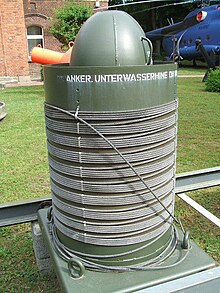Explosive buoy
Disintegrants buoys are mine nähnliche floating body with a small explosive charge , which in fields of moored mines are adapted between them to Minenräumversuche to complicate the opponent. Its purpose is to destroy the opposing clearing equipment by blowing it up. With tear buoys, they belong to the so-called barrier protection means or minefield protection means.

During the Second World War , the German navy mainly used the two types "Sprengboje C" (SprBC) and "Sprengboje D" (SprBD), which differed only insignificantly from one another. These were a 2 mm thick steel sheet produced, about 25 kg and 90 cm high Spitzboje (tapered upper part, hemispherical lower part) with a maximum of 34 cm diameter. The upper third protruded from the water if the anchor rope , which was a maximum of 100 m long, was not adjusted to the corresponding water depth. At the top of the buoy was a handle ring for loading and stowing the buoy. The safety rod of the firing pin igniter located at the bottom of the explosive charge, which reached through the entire buoy, ended in a screw below . In the lower third of the buoy, in the hemisphere, was the 800 g explosive charge in a sleeve, a hollow cylinder that was only held in place by a very thin shear pin . When during the evacuation attempt the evacuation hawser slid upwards on the anchor rope of the explosive buoy , it finally pressed against the thrust sleeve from below, whereby the shear pin was broken off. The movement of the released thrust sleeve triggered the firing pin igniter, which detonated the explosive charge and destroyed the clearing line with the buoy.
literature
- Military Arms Research Service: German Underwater Ordnance: Mines. Bureau of Ordnance Publication OP 1673A, Navy Department, Washington, DC, June 24, 1946, pp. 100-102 ; (also at: [1] )
- Karl von Kutzleben, Wilhelm Schroeder, Jochen Brennecke : Mine ships 1939–1945. The mysterious missions of the “midnight squadron”. Köhler, Herford 1974, ISBN 3-7822-0098-5 , pp. 25-27
- Technical service regulation TDv 1351 / 001-15.- Mine, Unterwasser, DM 21 (explosive buoy) , technical service regulations and manuals of the Bundeswehr